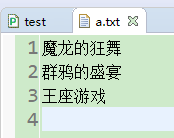目录
声明变量
类型转换
四则运算
列表List
循环
判断
字典
文件IO
函数
|
声明变量 |
# -*- coding: utf-8 -*- #整数 a = 10 print(a) #浮点数 b = 10.1 print(b) #字符串 c = "aaa10" print(c) print(type(a)) print(type(b)) print(type(c)) ''' 10 10.1 aaa10 <class 'int'> <class 'float'> <class 'str'> '''
|
类型转换 |
# -*- coding: utf-8 -*- a = "10" b = int(a) c = float(a) print(b) print(c) print(type(b)) print(type(c)) ''' 10 10.0 <class 'int'> <class 'float'> '''
|
四则运算 |
# -*- coding: utf-8 -*- a = 2 b = 3 print(a + b) print(a - b) print(a * b) print(a / b) print(a ** b) #a的b次方 ''' 5 -1 6 0.6666666666666666 8 '''
|
列表List |
# -*- coding: utf-8 -*- print("---------------声明与添加元素:-----------------") a = [] print(a) print(type(a)) a.append("你好") a.append(3) print(a) ''' [] <class 'list'> ['你好', 3] ''' print("---------------list索引与长度:-----------------") a = [2,4,6,8] print("list的长度是:" + str(len(a))) print(a[0]) print(a[1]) print(a[2]) print(a[3]) print(a[-1]) #打印最后一个元素 ''' list的长度是:4 2 4 6 8 8 ''' print("---------------list切片:-----------------") a = [2,4,6,8,10] print(a[1:3]) print(a[1:-1]) print(a[:3]) print(a[1:]) ''' [4, 6] [4, 6, 8] [2, 4, 6] [4, 6, 8, 10] ''' print("---------------遍历list:-----------------") a = [1,3,5,7] print("迭代器方式:") for i in a: print(i) print("遍历下标方式:") for i in range(len(a)): print(a[i]) ''' 迭代器方式: 1 3 5 7 遍历下标方式: 1 3 5 7 ''' print("---------------判断元素是否在list:-----------------") a = [1,3,5,7] print(1 in a) #True
|
循环 |
# -*- coding: utf-8 -*- a = [2,4,6,8] for i in a: print(i) ''' 2 4 6 8 ''' for i in range(5): print(i) ''' 0 1 2 3 4 ''' k = 1 while k<=3: print(k) k += 1 ''' 1 2 3 '''
|
判断 |
# -*- coding: utf-8 -*- a = True b = False print(type(a)) #<class 'bool'> a = 1 b = 2 print(a!=b) #True if a > b: print("a大于b") elif a < b: print("a小于b") else: print("a等于b") #a小于b
|
字典 |
# -*- coding: utf-8 -*- print("---------------声明与添加元素:-----------------") a = {} print(a) print(type(a)) a["Java"] = 1 a["Python"] = 2 a["Python"] = 3 print(a) ''' {} <class 'dict'> {'Java': 1, 'Python': 3} ''' print("---------------dict索引与长度:-----------------") a = {'Java': 1, 'Python': 2} print("dict的长度是:" + str(len(a))) print(a['Java']) print(a['Python']) ''' dict的长度是:2 1 2 ''' print("---------------遍历dict:-----------------") a = {'Java': 1, 'Python': 2, 'Scala': 3} for i in a.items(): print(i) ''' ('Java', 1) ('Python', 2) ('Scala', 3) ''' print("---------------返回dict的keys和values:-----------------") a = {'Java': 1, 'Python': 2, 'Scala': 3} print(a.keys()) print(a.values()) # dict_keys(['Java', 'Python', 'Scala']) # dict_values([1, 2, 3]) print("---------------应用:统计出现次数:-----------------") X = ['Java','Java','Python','Python','Python','Scala','Scala'] a = {} for x in X: res = a.get(x) if res == None: a[x] = 1 else: a[x] += 1 print(a) # {'Java': 2, 'Python': 3, 'Scala': 2} # 注意: 这样的实现方式效率最高,因为dict的查询复杂度是O(1); List查询复杂度是O(n)
|
文件IO |
# -*- coding: utf-8 -*- a = open("a.txt", encoding='UTF-8') for i in a: print(i) a.close() b = open("b.txt", "w", encoding='UTF-8') b.write("aa ") b.write("bb ") b.write("cc ") b.close()


|
函数 |
# -*- coding: utf-8 -*- def m1(name, age=5): h = 6 if age > h: print(name + "已经" + str(age) + "岁了,到了上小学的年龄") else: print(name + "只有" + str(age) + "岁,还不能上小学") m1("tom", 2) m1("peter") m1("tom", 10) ''' tom只有2岁,还不能上小学 peter只有5岁,还不能上小学 tom已经10岁了,到了上小学的年龄 '''